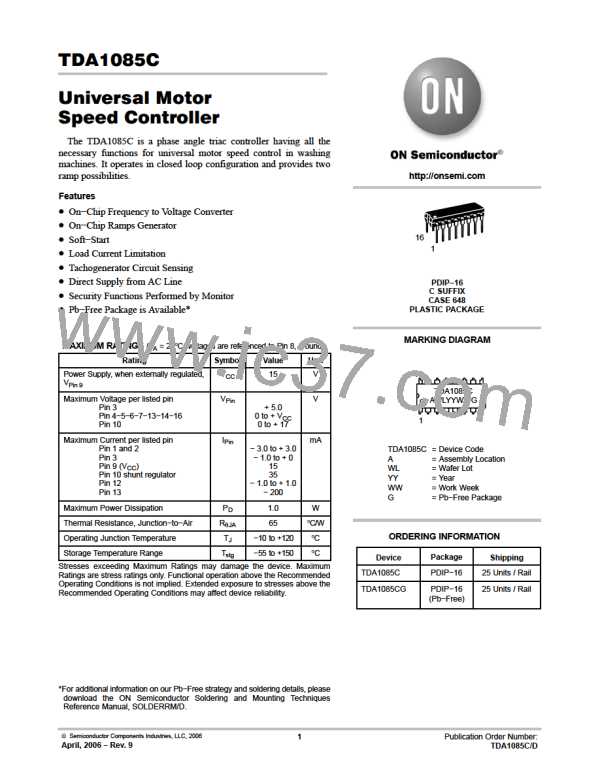TDA1085C
GENERAL DESCRIPTION
The TDA 1085C triggers a triac accordingly to the speed
consists in a full motor speed range with two acceleration
ramps which allow efficient washing machine control
(Distribute function).
Additionally, the TDA 1085C protects the whole system
against AC line stop or variations, overcurrent in the motor
and tachogenerator failure.
regulation requirements. Motor speed is digitally sensed by
a tachogenerator and then converted into an analog voltage.
The speed set is externally fixed and is applied to the
internal linear regulation input after having been submitted
to programmable acceleration ramps. The overall result
INPUT/OUTPUT FUNCTIONS
(Refer to Figures 1 and 8)
Voltage Regulator (Pins 9 and 10)
currents and temperature factor as well, down to neglectable
effects.
This is a parallel type regulator able to sink a large amount of
current and offering good characteristics. Current flow is
provided from AC line by external dropping resistors R1, R2,
and rectifier: This half wave current is used to feed a smothering
capacitor, the voltage of which is checked by the IC.
Pin 12 also has a monitoring function: when its voltage is
above 5.0 V, the trigger pulses are inhibited and the IC is
reset. It also senses the tachogenerator continuity, and in case
of any circuit aperture, it inhibits pulse, avoiding the motor to
run out of control. In the TDA 1085C, Pin 12 is negatively
clamped by an internal diode which removes the necessity of
the external one used in the former circuit.
When V is reached, the excess of current is derived by
CC
another dropping resistor R10 and by Pin 10. These three
resistors must be determined in order:
• To let 1.0 mA flow through Pin 10 when AC line is
Ramp Generator (Pins 5, 6, 7)
minimum and V consumption is maximum (fast
CC
The true Set Speed value taken in consideration by the
regulation is the output of the ramp generator (Pin 7). With
a given value of speed set input (Pin 5), the ramp generator
ramps and pulses present).
• To let V reach 3.0 V when AC line provides
10
maximum current and V consumption is minimum
CC
charges an external capacitor C
up to the moment V
Pin 7
Pin 5
(no ramps and no pulses).
(set speed) equals V
(true speed), see Figure 2. The IC
Pin 4
• All along the main line cycle, the Pin 10 dynamic range
has an internal charging current source of 1.2mA and
delivers it from 0 to 12 V at Pin 7. It is the high acceleration
ramp (5.0 s typical) which allows rapid motor speed changes
without excessive strains on the mechanics. In addition, the
TDA 1085C offers the possibility to break this high
acceleration with the introduction of a low acceleration
ramp (called Distribution) by reducing the Pin 7 source
current down to 5.0 mA under Pin 6 full control, as shown by
following conditions:
must not be exceeded unless loss of regulation.
An AC line supply failure would cause shut down.
The double capacitive filter built with R1 and R2 gives an
efficient V smoothing and helps to remove noise from set
CC
speeds.
Speed Sensing (Pins 4, 11, 12)
The IC is compatible with an external analog speed
sensing: its output must be applied to Pin 4, and Pin 12
connected to Pin 8.
• Presence of high acceleration ramp V
> V
Pin 4
Pin 5
• Distribution occurs in the V
range (true motor
Pin 4
x V
In most of the applications it is more convenient to use a
digital speed sensing with an inexpensive tachogenerator
which doesn′t need any tuning. During every positive cycle at
speed) defined by V
x 2.0 V
Pin 6
Pin 4
Pin 6
For two fixed values of V
and V
, the motor speed
Pin 5
Pin 6
will have high acceleration, excluding the time for V
to
Pin 12, the capacitor C
is charged to almost V and
Pin 4
Pin 11
CC
go from V
to two times this value, high acceleration
during this time, Pin 4 delivers a current which is 10 times the
one charging C . The current source gain is called G and
Pin 6
again, up to the moment the motor has reached the set speed
value, at which it will stay, see Figure 3.
Should a reset happen (whatever the cause would be), the
above mentioned successive ramps will be fully reprocessed
Pin 11
is tightly specified, but nevertheless requires an adjustment on
. The current into this resistor is proportional to C
R
Pin 4
Pin 11
and to the motor speed; being filtered by a capacitor, V
Pin 4
from 0 to the maximum speed. If V
acceleration ramp occurs.
= 0, only the high
becomes smothered and represents the “true actual motor
speed”.
Pin 6
To get a real zero speed position, Pin 5 has been designed
in such a way that its voltage from 0 to 80 mV is interpreted
as a true zero. As a consequence, when changing the speed
set position, the designer must be sure that any transient zero
would not occur: if any, the entire circuit will be reset.
To maintain linearity into the high speed range, it is important
to verify that C
is fully charged: the internal source on Pin
Pin 11
11 has 100 KW impedance. Nevertheless C
has to be as
Pin 11
high as possible as it has a large influence on FV/C temperature
factor. A 470 KW resistor between Pins 11 and 9 reduces leakage
http://onsemi.com
4

 ONSEMI [ ONSEMI ]
ONSEMI [ ONSEMI ]